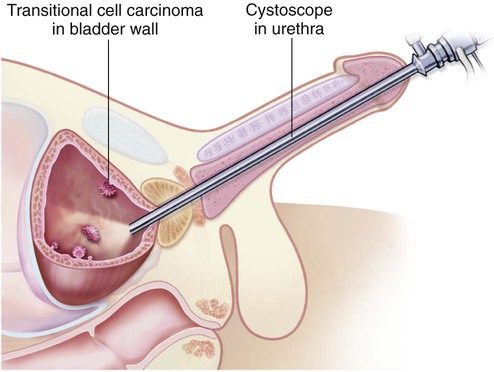Chapter 17 *A transition syllable or vowel may be added to or deleted from the word parts to make the combining form. The urinary system has two primary functions: The urinary system filters about 180 L of blood plasma daily. On average 1.0 to 1.5 L of urine is formed and excreted daily to remove waste products. The amount of urine formed is controlled largely by hormones. An increase in the antidiuretic hormone, from the pituitary gland, decreases the amount of water excreted by the kidneys. An increase in the amount of aldosterone, from the adrenal gland, conserves sodium in the plasma, causing water to be retained. The urinary system consists of two kidneys, ureters, the bladder, and the urethra (Fig. 17-1). The basic structural unit of the urinary system is the kidney. Each kidney is about 4 inches (10 cm) long and 2 inches (5 cm) wide and weighs about 150 g. Each kidney contains about one to two million nephrons, the tiny structures that filter the blood (Fig. 17-2). The nephron is the location of formation of urine and is the functional unit of the urinary system. The process by which the urine is filtered in the nephron is complex (Table 17-1). The kidney has three layers (Fig. 17-3): TABLE 17-1 Urine normally consists of 95% water. The remaining 5% includes waste products from the breakdown of protein, hormones, electrolytes, pigments, toxins, and any abnormal components (Table 17-2). Urine is normally sterile in the kidneys and bladder. TABLE 17-2
Urinary System
 Define at least 10 terms relating to the urinary system.
Define at least 10 terms relating to the urinary system.
 Describe the two functions of the urinary system.
Describe the two functions of the urinary system.
 Identify four structures of the urinary system.
Identify four structures of the urinary system.
 Identify the function of at least three structures of the kidney.
Identify the function of at least three structures of the kidney.
 Identify at least five components normally found in urine.
Identify at least five components normally found in urine.
 Describe the possible cause of at least five abnormal components of urine.
Describe the possible cause of at least five abnormal components of urine.
 Describe at least three methods used to assess disorders of the urinary system.
Describe at least three methods used to assess disorders of the urinary system.
Term
Definition
Prefix
Root
Suffix
Cystocele
Tumor or swelling of the bladder
cyst/o
cele
Cystoscopy
Examination of the bladder
cyst/o
scopy
Lithotomy
Incision into a stone
lith
otomy
Nephrology
Study of the kidney
nephr
ology
Nephropexy
Fixation of the kidney
nephr/o
pexy
Nocturia
Urination at night
noct
uria
Pyelonephrectomy
Removal of the kidney pelvis
pyel/o
nephr
ectomy
Pyuria
Pus in the urine
py
uria
Renal
Pertaining to the kidney
ren
al
Renal calculus
Kidney stone
calculus
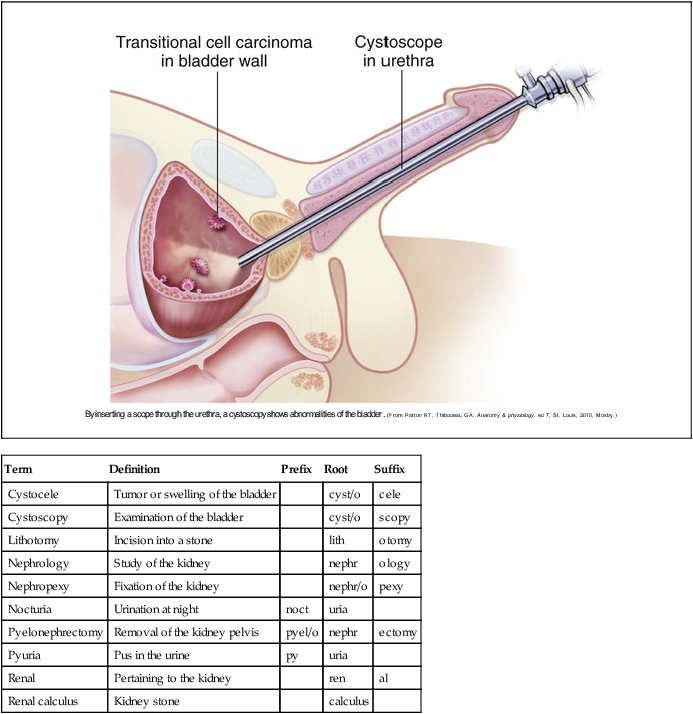
Structure and Function of the Urinary System
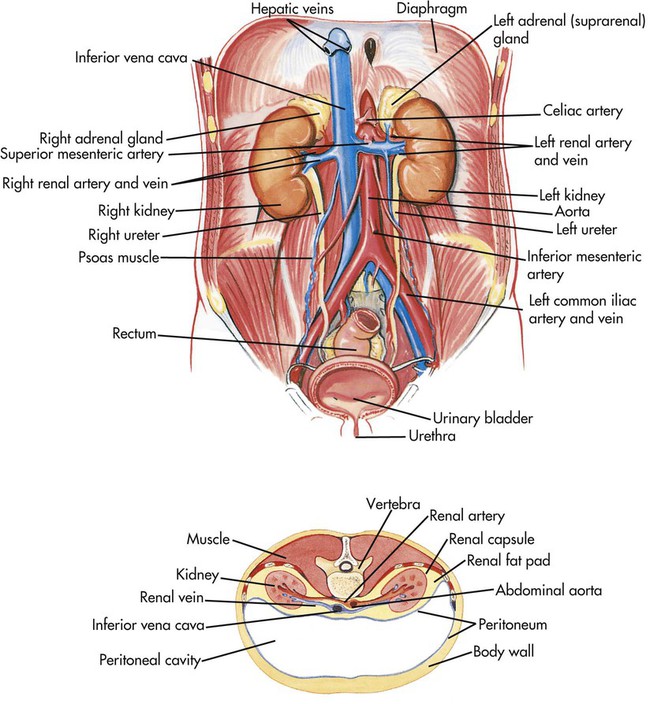
Kidneys
Section of Nephron
Function
Renal arterioles
Carry blood to nephron
Bowman’s capsule
Filters out water, glucose, and electrolytes (Na+, Cl–)
Proximal tubule
Reabsorbs glucose, some electrolytes (Na+, Cl–), and water
Loop of Henle
Secretes urea, reabsorbs electrolytes (Na+, Cl–), and water
Distal tubule
Secretes ammonia, some electrolytes (K+, H+), and some drugs
Collecting duct
Reabsorbs electrolytes (Na+) and urea; secretes ammonia and electrolytes (K+, H+)
Renal venules
Return blood to the body
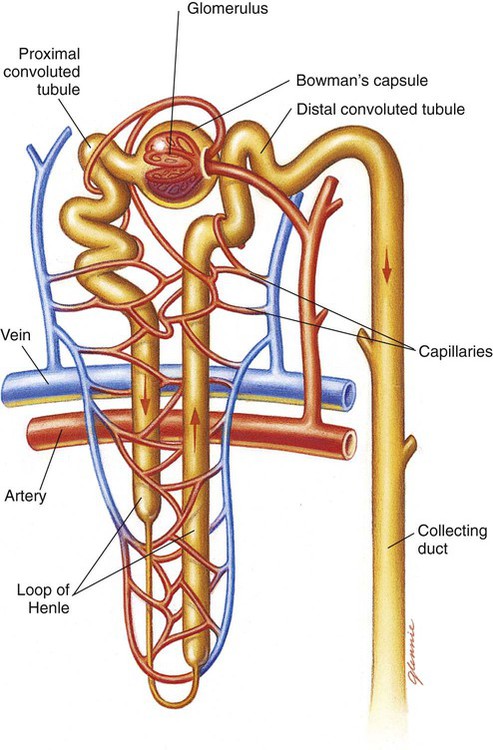
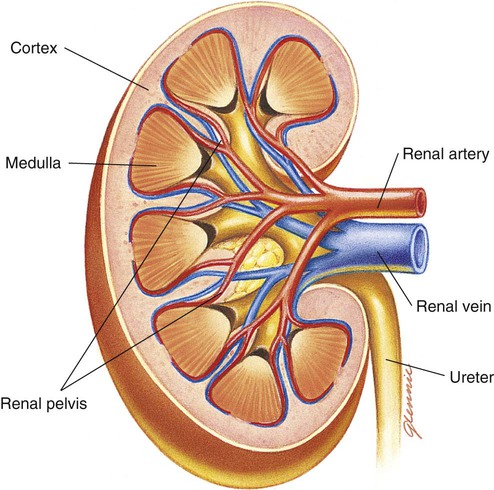
 The cortex, the outer layer, is composed of soft, granular, reddish brown tissue.
The cortex, the outer layer, is composed of soft, granular, reddish brown tissue.
 The renal pelvis is the funnel-shaped innermost structure that collects and temporarily stores urine as it is formed.
The renal pelvis is the funnel-shaped innermost structure that collects and temporarily stores urine as it is formed.
Urine Formation
Characteristic
Normal
Abnormal
Volume
1-1.5 L/day
Polyuria (>2.0 L/day)
Oliguria (<0.5 L/day)
Odor
None
Sweet (sugar)
Ammonia (old)
Offensive (bacteria)
Color
Yellow, straw, amber
Red (blood, infection, some drugs)
Brown (bile)
Orange, blue (drugs)
Turbidity
Clear
Cloudy (pus, bacteria, cells, fat, phosphates)
pH
4.8-7.4 (average 6)
Alkaline (phosphates, vegetarian diet)
Specific gravity
1.002-1.040
High (dehydration)
Low (diuresis)
Abnormal Component
Possible Cause
Sugar (glycosuria)
Diabetes mellitus
Protein (albuminuria)
Renal disease
Ketones (ketonuria)
Incomplete fat metabolism, diabetes mellitus
Blood (hematuria)
Infection, injury
Pus (pyuria)
Infection
Bacteria (bacteriuria)
Infection
Casts
Dead cells, injury ![]()
Stay updated, free articles. Join our Telegram channel

Full access? Get Clinical Tree


Urinary System

